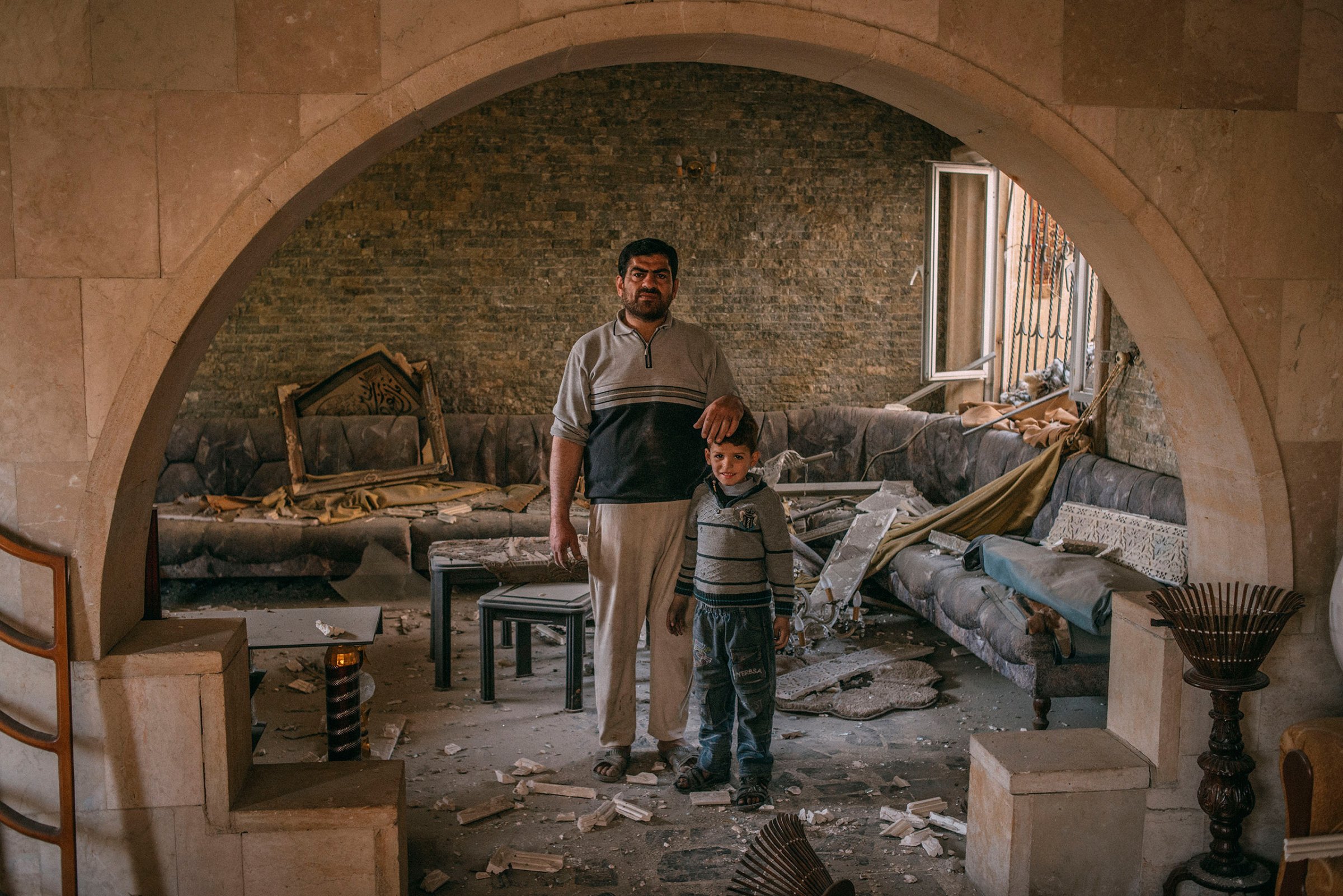
In late February, as Iraqi troops advanced on the western half of the city of Mosul, ISIS gunmen barged through Median Hikmat al-Galou’s house, commandeering it for the battle that now raged around them. One of the militants set fire to a car sitting in the front driveway. He spoke in broken Arabic, leading Galou to believe he was Russian. “Islam needs smoke,” he said as the car went up in flames, creating a black plume that would help the gunmen conceal their position from the U.S. and allied warplanes that targeted them from above. The gunmen moved into the house, and later took Galou’s entire family hostage, using them as human shields in their own home and in a nearby house.
This type of horror has become familiar to residents of western Mosul as Islamic State militants have put civilians in the line of fire as Iraqi troops and U.S.-led coalition warplanes intensify their assault on the city. As many as 500,000 civilians are trapped in the section of Mosul still controlled by ISIS with shrinking supplies of food, fuel, and drinkable water. Reports of civilian deaths in the battle surged to an all-time high in March, with an alleged U.S. strike reportedly killing as many as 200 people.
After battling through Mosul’s neighborhoods east of the Tigris River last year, Iraq’s armed forces launched a renewed offensive to reclaim the western half of the city in February. The battle aims to reverse the Iraqi military’s embarrassing collapse in the summer of 2014 when ISIS swept across a vast portion of Iraqi territory and conquered Mosul, Iraq’s second city. Western Mosul’s more densely populated neighborhoods have added an additional challenge for the government forces retaking the city street by street — especially as the militants deliberately put the innocent in harm’s way.

In interviews on Wednesday, residents of western Mosul described being corralled from place to place by ISIS gunmen mounting a chaotic defense of the last neighborhoods of the city under their control.
“They treated us like cattle,” says Hashem Yasin Younis, 47, who said he and his family were also taken captive in recent weeks. He said at they were taken at first to the Mosul train station along with hundreds of others, and later to Mosul’s Mansour district, before being freed by the federal police.
Galou, who is 37 and has a small business providing electric generators, said the gunmen who invaded his house at the end of February stayed for three days. The militants then moved his entire family to another house adjacent to a nearby mosque, where they survived on rations of buffalo milk for nine days before being freed by Iraq’s Federal Police. “They just took us,” he said. “For nine days we only ate milk, sitting there and that’s it.” He calls the officers who liberated them “heroes.”
In the time that he was away from his two-story home, his block was bombed by coalition warplanes. Inside his house on Wednesday, the family picked through heaps of splintered furniture, scraps of metal, and random household items, carting away what they could still salvage. Asked what he thinks of the coalition airstrikes that damaged his home, he said, “It’s fine for ISIS to go to their heaven, but we don’t accept the killing of children.”
Across the street from where Galou stood, the body of a young dead man lay in the street. Passersby denounced the black-clad corpse as that of an ISIS member. Their claims were impossible to verify.

The reclaimed neighborhoods of the city are a shattered landscape of bombed-out buildings and cars, even trucks flung aside or flipped over by powerful explosions. ISIS fighters also left behind some of the traces of their brand of insurgent warfare. Inside one house, piles of homemade mortars were stacked high. Outside, a series of civilian cars that commanders from Iraq’s Rapid Response division said were intended to become car bombs. One car, a yellow sedan sat with its hood raised and pieced of its seats ripped out, lying on a stretch of grass.
The perils of the offensive on Western Mosul reached a peak on March 17 when as many as 200 civilians died in alleged U.S. airstrike. The military acknowledged that it carried out an attack in the same place on the same day. On Tuesday, Lieutenant General Stephen Townsend acknowledged that there was a “fair chance” that the U.S. was responsible for the blast. Iraqi military officials have also said Islamic State booby traps were to blame for the deaths.
The U.N. human rights office denounced the climbing civilian death toll, blaming both the airstrikes and the actions of ISIS. “Bodies continue to be found in buildings where civilians were reportedly held by ISIL as human shields, and were subsequently killed by airstrikes,” the Office of the UN High Commissioner for Human Rights said in a statement.
Intense fighting continued on Wednesday as Iraqi forces pushed closer to the Nouri mosque, a symbolically powerful target where ISIS leader Abu Bakr al-Baghdadi described himself as the leader of a worldwide “caliphate.” In the area near the mosque, helicopter gunships launched air raids, sending up huge clouds of smoke.
More Must-Reads from TIME
- Donald Trump Is TIME's 2024 Person of the Year
- Why We Chose Trump as Person of the Year
- Is Intermittent Fasting Good or Bad for You?
- The 100 Must-Read Books of 2024
- The 20 Best Christmas TV Episodes
- Column: If Optimism Feels Ridiculous Now, Try Hope
- The Future of Climate Action Is Trade Policy
- Merle Bombardieri Is Helping People Make the Baby Decision
Contact us at letters@time.com